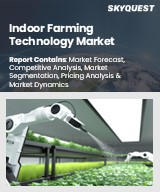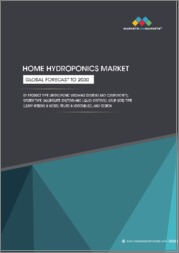
|
시장보고서
상품코드
1800123
세계의 수경재배 시장 예측(2025-2030년)Global Hydroponics Market - Forecasts fom 2025 to 2030 |
||||||
수경 재배 시장은 CAGR 8.35%로 2025년 133억 100만 달러, 2030년 198억 6,200만 달러로 성장할 것으로 예측됩니다.
수경 재배는 식물의 뿌리를 영양이 풍부한 수용액에 담그는 토양을 사용하지 않는 농법이며, 세계의 식량 안보의 과제에 대처하는 지속 가능한 솔루션으로서 지지를 모으고 있습니다. 이 기술은 토양과 관련된 질병을 제거하고 자원 활용을 최적화하기 때문에 딸기, 토마토, 오이, 고추, 양상추 등 수요가 높은 작물에 이상적입니다. 이 시장은 식량농업기구(FAO)가 2050년까지 91억 명에 달할 것으로 예상하는 전 세계 인구를 먹여 살리기 위한 필요성에 의해 추진되고 있으며, 2005-2007년 수준에서 식량 생산량이 70% 증가할 것으로 예상하고 있습니다. 수경 재배는 제한된 공간에서 높은 수율의 농업을 가능하게하고 경지 부족에 직면하는 지역에 호소하기 때문입니다.
성장의 원동력
경작지 감소
도시화와 상업개발로 인한 농지 감소는 주요 촉진요인입니다. 전통적인 농지가 감소하는 가운데, 수경 재배는 효율적인 대안을 제공하고 작물의 생산량을 극대화하면서 더 적은 공간으로 끝납니다. 이것은 경쟁하는 토지 이용과 열화가 기존의 농업의 과제가 되고 있는 선진국이나 개발도상국에서 특히 중요합니다.
투자 증가
엄청난 투자가 시장 성장을 뒷받침하고 있습니다. 예를 들어, 대규모 수경 재배 시설은 신선한 농산물 수요 증가에 대응하기 위해 설립되고 있습니다. 이러한 투자는 생산성과 지속가능성을 높이기 위해 인프라를 확장하고 자동 영양 공급 시스템과 같은 첨단 기술을 통합하는 데 중점을 둡니다. 수경 재배는 기존의 농업에 비해 물 사용량을 95% 삭감할 수 있기 때문에 물이 부족한 지역에서의 채택을 더욱 뒷받침하고 있습니다.
지리적 전망
미국은 수경 재배의 주요 성장 시장이며, 신선한 야채, 특히 샐러드와 피망 수요 증가에 견인되고 있습니다. 잎 야채의 소비 증가와 수직 및 수익 주도형 농업으로의 이동이 시장 확대를 뒷받침하고 있습니다. 수경재배농장의 설립과 함께 식물영양학의 연구개발이 호조로 성장을 지지하고 있습니다. 미국은 인구 증가에 따른 식량 수요에 대응하기 위해 현대적 농업 기술에 주력하고 있으며 수경 재배 기술 혁신의 리더로 자리매김하고 있습니다. 아시아태평양은 인도와 중국과 같은 국가에서 도시화와 지속 가능한 농업에 대한 수요로 인해 큰 성장이 예상됩니다.
시장 역학
시장은 초기설정 비용의 높이나 전문 기술의 필요성과 같은 과제에 직면하고 있어, 지역에 따라서는 도입이 제한될 가능성이 있습니다. 그러나 고가치 작물을 위한 용도의 확장과 실시간 모니터링을 위한 IoT와 같은 스마트 기술의 통합과 같은 기회는 풍부합니다. Porter's Five Forces 분석은 경쟁업체 간의 적대관계와 공급업체의 역학을 부각시켜 지속가능한 농업에 대한 규제지원이 시장의 매력을 높이고 있습니다.
이 보고서의 주요 이점
- 통찰력 있는 분석 : 고객 부문, 정부 정책 및 사회경제 요인, 소비자 선호도, 산업별 및 기타 부문 부문에 중점을 두어 주요 지역뿐만 아니라 신흥 지역도 다루는 상세한 시장 고려사항을 얻을 수 있습니다.
- 경쟁 구도 : 세계 주요 기업이 채택하는 전략적 전략을 이해하고 적절한 전략으로 시장 침투 가능성을 이해할 수 있습니다.
- 시장 동향과 촉진요인 : 역동적인 요인과 매우 중요한 시장 동향, 그리고 그들이 향후 시장 개척을 어떻게 형성해 나갈지 탐구합니다.
- 행동 가능한 제안 : 역동적인 환경에서 새로운 비즈니스 스트림과 수익을 발굴하기 위한 전략적 의사결정에 통찰력을 활용합니다.
- 폭넓은 이용자에 대응 : 신흥기업, 연구기관, 컨설턴트, 중소기업, 대기업에 유익하고 비용 효율적인 요인.
어떤 용도로 사용됩니까?
업계 및 시장 인사이트, 사업 기회 평가, 제품 수요 예측, 시장 진출 전략, 지리적 확대, 설비 투자 결정, 규제 프레임워크과 영향, 신제품 개척, 경쟁의 영향
조사 범위
- 2020년부터 2024년까지의 과거 데이터 & 2025년부터 2030년까지의 예측 데이터
- 성장 기회, 과제, 공급망 전망, 규제 틀 및 추세 분석
- 경쟁 포지셔닝, 전략 및 시장 점유율 분석
- 수익 성장 및 예측 국가를 포함한 부문 및 지역 분석
- 기업 프로파일링(특히 재무 정보 및 주요 개발)
수경 재배 시장 세분화
유형별
- Deep Water Culture
- Nutrient Film Technique System
- Aeroponics
- 기타
입력별
- 성장 배지
- 양분
작물 유형별
- 야채 및 과일
- 허브
- 꽃과 장식용 작물
재배 유형별
- 실내
- 옥외
지역별
- 북미
- 미국
- 캐나다
- 멕시코
- 남미
- 브라질
- 아르헨티나
- 기타
- 유럽
- 독일
- 영국
- 프랑스
- 기타
- 중동 및 아프리카
- 사우디아라비아
- UAE
- 기타
- 아시아태평양
- 중국
- 일본
- 인도
- 한국
- 태국
- 인도네시아
- 대만
- 기타
목차
제1장 주요 요약
제2장 시장 현황
- 시장 개요
- 시장의 정의
- 조사 범위
- 시장 세분화
제3장 비즈니스 상황
- 시장 성장 촉진요인
- 시장 성장 억제요인
- 시장 기회
- Porter's Five Forces 분석
- 업계 밸류체인 분석
- 정책 및 규정
- 전략적 제안
제4장 기술 전망
제5장 수경 재배 세계 시장 : 유형별
- 소개
- 깊은 물 문화
- 영양 필름 기술 시스템
- 에어로포닉스
- 기타
제6장 수경 재배 세계 시장 : 투입물별
- 소개
- 성장 배지
- 영양소
제7장 수경 재배 세계 시장 :작물 유형별
- 소개
- 과일 및 채소
- 허브
- 꽃과 관상용 작물
제8장 수경재배 세계 시장 : 농업유형별
- 소개
- 실내
- 옥외
제9장 수경재배 세계 시장 : 지역별
- 소개
- 북미
- 미국
- 캐나다
- 멕시코
- 남미
- 브라질
- 아르헨티나
- 기타
- 유럽
- 독일
- 프랑스
- 영국
- 스페인
- 기타
- 중동 및 아프리카
- 사우디아라비아
- 아랍에미리트(UAE)
- 기타
- 아시아태평양
- 중국
- 인도
- 일본
- 한국
- 인도네시아
- 태국
- 기타
제10장 경쟁 환경과 분석
- 주요 기업과 전략 분석
- 시장 점유율 분석
- 합병, 인수, 합의 및 협업
- 경쟁 대시보드
제11장 기업 프로파일
- General Hydroponics Inc.
- Hydrofarm LLC
- AmHydro
- Gardyn
- Fork Farms
- CropKing Incorporated.
- Freight Farms Inc.
- FarmBox Foods
- Hydronov
제12장 부록
- 통화
- 전제조건
- 기준연도과 예측연도의 타임라인
- 이해 관계자에게 있어서의 주요 이점
- 조사 방법
- 약어
The Global Hydroponics Market is expected to grow from USD 13.301 billion in 2025 to USD 19.862 billion in 2030, at a CAGR of 8.35%.
Hydroponics, a soil-less farming method where plant roots are submerged in nutrient-rich water solutions, is gaining traction as a sustainable solution to address global food security challenges. The technique eliminates soil-related diseases and optimizes resource use, making it ideal for high-demand crops like strawberries, tomatoes, cucumbers, peppers, and lettuce. The market is propelled by the need to feed a growing global population, projected by the Food and Agriculture Organization (FAO) to reach 9.1 billion by 2050, requiring a 70% increase in food production from 2005-2007 levels. Urbanization and land degradation further drive adoption, as hydroponics enables high-yield farming in limited spaces, appealing to regions facing arable land scarcity.
Growth Drivers
Reduction in Arable Land
The decline in agricultural land due to urbanization and commercial development is a major driver. As traditional farmland diminishes, hydroponics offers an efficient alternative, requiring less space while maximizing crop output. This is particularly critical in developed and developing countries where competing land use and degradation challenge conventional agriculture.
Increasing Investments
Significant investments are fueling market growth. For instance, large-scale hydroponic facilities are being established to meet rising demand for fresh produce. These investments focus on scaling infrastructure and integrating advanced technologies, such as automated nutrient delivery systems, to enhance productivity and sustainability. Hydroponics' ability to use 95% less water than traditional farming further supports its adoption in water-scarce regions.
Geographical Outlook
The USA is a key growth market for hydroponics, driven by rising demand for fresh vegetables, particularly salad greens and peppers. The increasing consumption of leafy vegetables and the shift toward vertical and profit-driven farming bolster market expansion. Favorable research and development in plant nutrition, coupled with the establishment of hydroponic farms, supports growth. The USA's focus on modern farming technologies to address food demand, fueled by population growth, positions it as a leader in hydroponic innovation. The Asia Pacific region is also expected to see significant growth, driven by urbanization and demand for sustainable farming in countries like India and China.
Market Dynamics
The market faces challenges such as high initial setup costs and technical expertise requirements, which may limit adoption in some regions. However, opportunities abound in expanding applications for high-value crops and integrating smart technologies like IoT for real-time monitoring. Porter's Five Forces analysis highlights competitive rivalry and supplier dynamics, while regulatory support for sustainable agriculture enhances market attractiveness.
Key Benefits of this Report:
- Insightful Analysis: Gain detailed market insights covering major as well as emerging geographical regions, focusing on customer segments, government policies and socio-economic factors, consumer preferences, industry verticals, and other sub-segments.
- Competitive Landscape: Understand the strategic maneuvers employed by key players globally to understand possible market penetration with the correct strategy.
- Market Drivers & Future Trends: Explore the dynamic factors and pivotal market trends and how they will shape future market developments.
- Actionable Recommendations: Utilize the insights to exercise strategic decisions to uncover new business streams and revenues in a dynamic environment.
- Caters to a Wide Audience: Beneficial and cost-effective for startups, research institutions, consultants, SMEs, and large enterprises.
What do businesses use our reports for?
Industry and Market Insights, Opportunity Assessment, Product Demand Forecasting, Market Entry Strategy, Geographical Expansion, Capital Investment Decisions, Regulatory Framework & Implications, New Product Development, Competitive Intelligence
Report Coverage:
- Historical data from 2020 to 2024 & forecast data from 2025 to 2030
- Growth Opportunities, Challenges, Supply Chain Outlook, Regulatory Framework, and Trend Analysis
- Competitive Positioning, Strategies, and Market Share Analysis
- Revenue Growth and Forecast Assessment of segments and regions including countries
- Company Profiling (Strategies, Products, Financial Information, and Key Developments among others.
Global Hydroponics Market Segmentation
By Type
- Deep Water Culture
- Nutrient Film Technique System
- Aeroponics
- Others
By Input
- Growth Medium
- Nutrients
By Crop Type
- Fuits & Vegetables
- Herbs
- Flowers & Ornamental Crops
By Farming Type
- Indoor
- Outdoor
By Geography
- North America
- USA
- Canada
- Mexico
- South America
- Brazil
- Argentina
- Others
- Europe
- Germany
- United Kingdom
- France
- Others
- Middle East and Africa
- Saudi Arabia
- UAE
- Others
- Asia Pacific
- China
- Japan
- India
- South Korea
- Thailand
- Indonesia
- Taiwan
- Others
TABLE OF CONTENTS
1. EXECUTIVE SUMMARY
2. MARKET SNAPSHOT
- 2.1. Market Overview
- 2.2. Market Definition
- 2.3. Scope of the Study
- 2.4. Market Segmentation
3. BUSINESS LANDSCAPE
- 3.1. Market Drivers
- 3.2. Market Restraints
- 3.3. Market Opportunities
- 3.4. Porter's Five Forces Analysis
- 3.5. Industry Value Chain Analysis
- 3.6. Policies and Regulations
- 3.7. Strategic Recommendations
4. TECHNOLOGICAL OUTLOOK
5. GLOBAL HYDROPONICS MARKET BY TYPE
- 5.1. Introduction
- 5.2. Deep Water Culture
- 5.3. Nutrient Film Technique System
- 5.4. Aeroponics
- 5.5. Others
6. GLOBAL HYDROPONICS MARKET BY INPUT
- 6.1. Introduction
- 6.2. Growth Medium
- 6.3. Nutrients
7. GLOBAL HYDROPONICS MARKET BY CROP TYPE
- 7.1. Introduction
- 7.2. Fruits & Vegetables
- 7.3. Herbs
- 7.4. Flowers & Ornamental Crops
8. GLOBAL HYDROPONICS MARKET BY FARMING TYPE
- 8.1. Introduction
- 8.2. Indoor
- 8.3. Outdoor
9. GLOBAL HYDROPONICS MARKET BY GEOGRAPHY
- 9.1. Introduction
- 9.2. North America
- 9.2.1. USA
- 9.2.2. Canada
- 9.2.3. Mexico
- 9.3. South America
- 9.3.1. Brazil
- 9.3.2. Argentian
- 9.3.3. Others
- 9.4. Europe
- 9.4.1. Germany
- 9.4.2. France
- 9.4.3. United Kingdom
- 9.4.4. Spain
- 9.4.5. Others
- 9.5. Middle East and Africa
- 9.5.1. Saudi Arabia
- 9.5.2. UAE
- 9.5.3. Others
- 9.6. Asia Pacific
- 9.6.1. China
- 9.6.2. India
- 9.6.3. Japan
- 9.6.4. South Korea
- 9.6.5. Indonesia
- 9.6.6. Thailand
- 9.6.7. Others
10. COMPETITIVE ENVIRONMENT AND ANALYSIS
- 10.1. Major Players and Strategy Analysis
- 10.2. Market Share Analysis
- 10.3. Mergers, Acquisitions, Agreements, and Collaborations
- 10.4. Competitive Dashboard
11. COMPANY PROFILES
- 11.1. General Hydroponics Inc.
- 11.2. Hydrofarm LLC
- 11.3. AmHydro
- 11.4. Gardyn
- 11.5. Fork Farms
- 11.6. CropKing Incorporated.
- 11.7. Freight Farms Inc.
- 11.8. FarmBox Foods
- 11.9. Hydronov
12. APPENDIX
- 12.1. Currency
- 12.2. Assumptions
- 12.3. Base and Forecast Years Timeline
- 12.4. Key Benefits for the Stakeholders
- 12.5. Research Methodology
- 12.6. Abbreviations



















